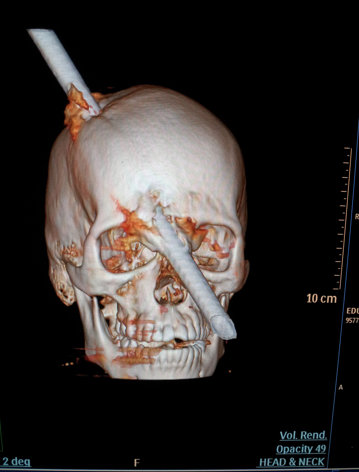Aug 21 2012
Phineas Gage Revisited
It is always amazing to see people survive and recover from massive brain trauma. The first medically described case of this is the now famous Phineas Gage(whose fame is probably at least partly due to the fact that his name is so memorable – very Dickensian). Gage was a railroad worker who was injured when he was tamping down explosives with an iron rod. A spark set off the explosives, sending the rod up and through his skull like a bullet. He somehow survived and remained conscious long enough to make it to help. He later was noted to have a significantly changed personality – disinhibited, profane, and restless with an inability to plan and control his behavior. He suffered from seizures following the injury, probably an infection, and died about 12 years later.
Recently we have a similar case from Brazil – Eduardo Leite, a construction worker, was struck by a metal rod which fell from several stories up. The rod pierced his hard hat, went through the top of his skull on the right, and then exited between his eyes. Like Gage, Leite remained conscious, and was able to tell the emergency workers the story of what happened.
Leite went through a five hour surgery to remove the rod, which had to be pulled through in the direction it pierced the skull. According to report Leite is doing well and will likely recover with few deficits.
The image is quite impressive, and it may seem amazing that anyone could survive such an injury to the brain, let alone with few deficits. However, a little knowledge of brain anatomy explains why this is possible.
From the images it appears that the rod went through the right frontal lobe. This is the most redundant part of the brain. Much of the function of the far frontal lobes is bilaterally redundant, meaning that either side (left or right) can function fine by itself. There are some lateralized functions there, like the frontal eye fields which control eye gaze – the right frontal eye fields will move the eyes to the left. But those structures could easily have been spared.
When neurosurgeons have to place an instrument through the brain, they generally do so through the right (non-dominant for most people) frontal lobe. When placing a ventricular shunt, for example, to drain fluid and reduce pressure build up inside the brain, they will place the tube through the right frontal lobe.
Leite’s injury, therefore, could not have been more perfectly placed in order to minimize neurological damage. From that point of view he was lucky – of course it’s not very lucky to have a metal rod fall through your head.
If you look at the Gage image you can see that the injury was more in the midline, and likely damaged both frontal lobes, hence the significant personality change.
Unlike Gage, Leite is also likely to do well long term. He may develop a seizure disorder from the injury, but this can be managed with anti-seizure medication. His recovery can be monitored with CT scans and MRI scans, and any rebleeding or complication can be treated. If he develops an infection that can be cleared up with antibiotics.
Of course, these cases are uncommon. Most people who have a metal rod shoot through their skull and brain either don’t survive or have significant deficits. The unlikely, however, will happen every now and then, given enough opportunity. It seems every few years a case like this crops up in the media, with impressive images of projectiles through the skull and amazing stories of how the victim survived with remarkably few deficits. With almost 7 billion people in the world, even very unlikely events will happen on a regular basis, and thanks to mass media and the internet you are likely to hear about it.








